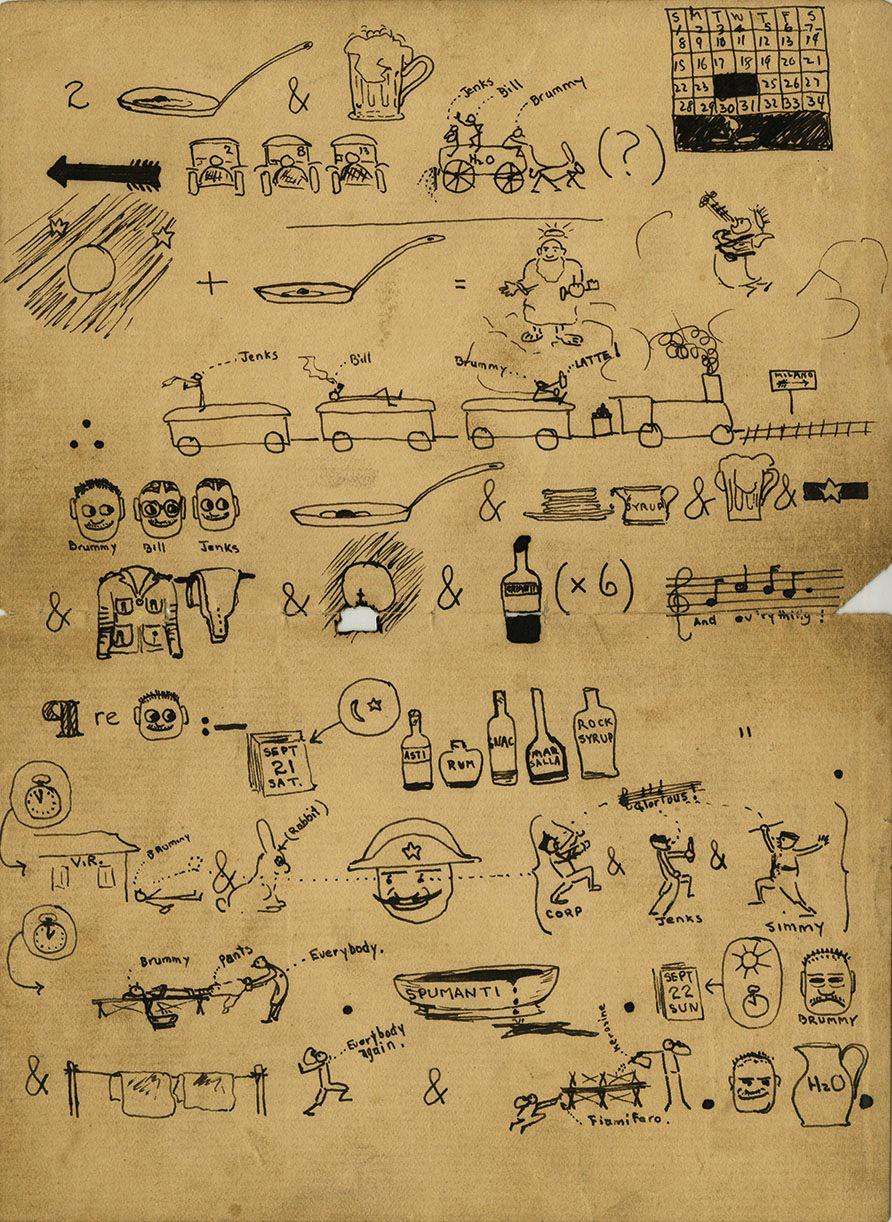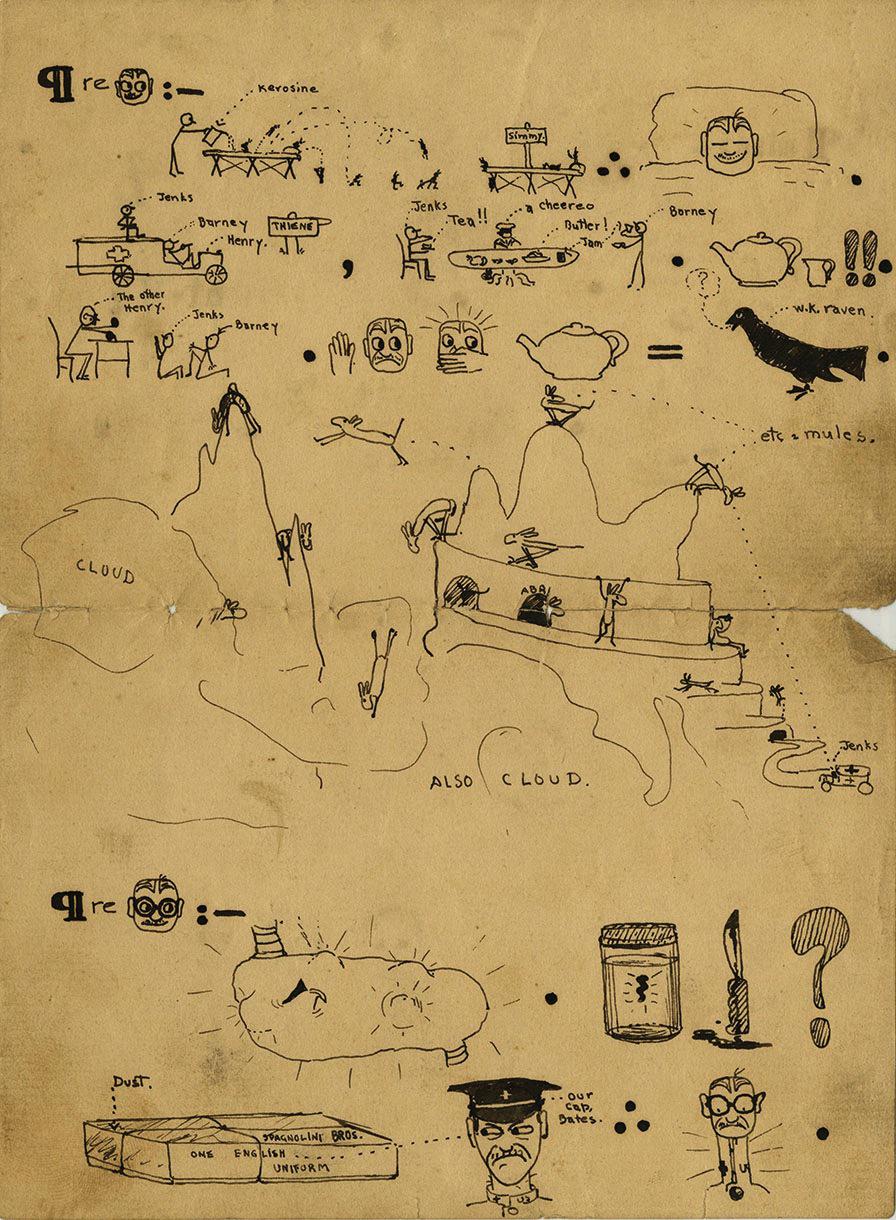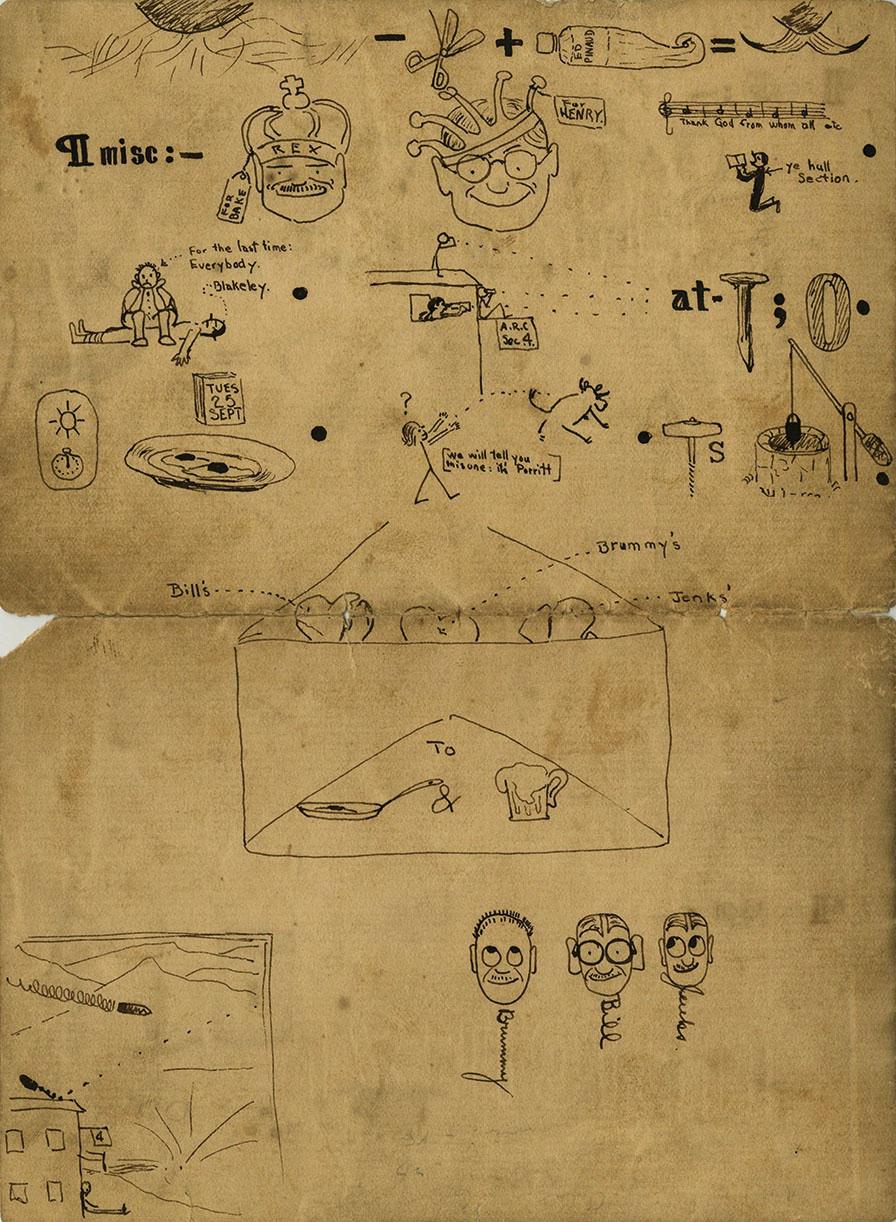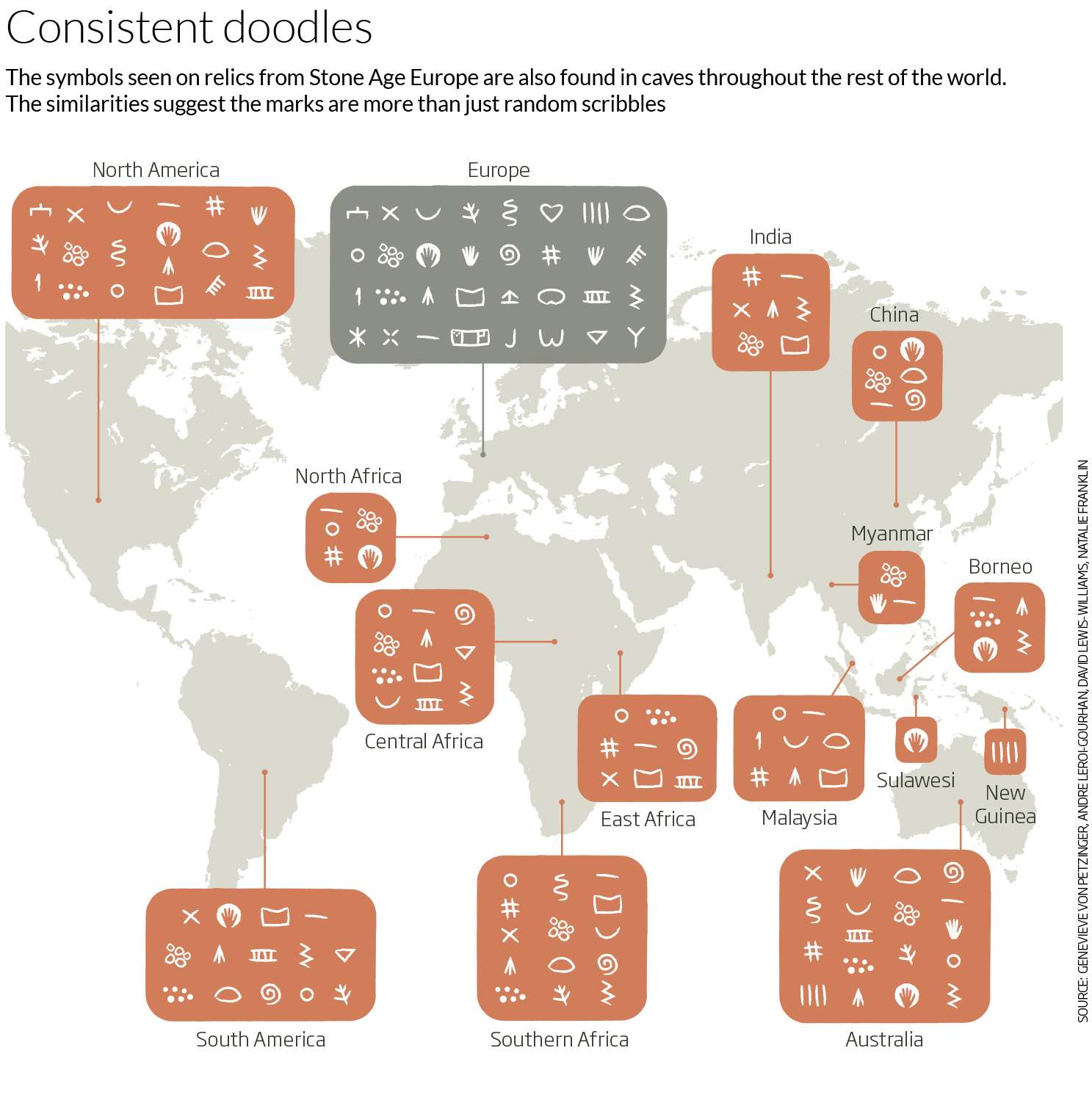[Most Recent Entries] [Calendar View]
Friday, March 1st, 2019
| Time | Event |
| 9:00a | The Elaborate Pictogram Ernest Hemingway Received in the Hospital During WWI: Can You Decode Its Meaning?
Everyone who knows the work of Ernest Hemingway knows A Farewell to Arms, and everyone who knows A Farewell to Arms knows that Hemingway drew on his experience as a Red Cross ambulance driver in Italy during World War I. Just a few months after shipping out, the eighteen-year-old writer-to-be — filled, he later said, with "a great illusion of immortality" — got caught by mortar fire while taking chocolate and cigarettes from the canteen to the front line. Recovering from his wounds in a Milanese hospital, he fell in love with an American nurse named Agnes Hannah von Kurowsky, who would become the model for Catherine Barkley in A Farewell to Arms.
Hemingway wrote that novel years after Kurowsky had left him for an Italian officer, but when their prospects still looked good, they received this curious letter, which at first glance looks like nothing more than a few pages of doodles. "We think it may be a rebus or another type of pictogram that uses pictures to represent words, parts of words, or phrases," wrote Jessica Green, an intern at the John F. Kennedy Presidential Library where it turned up, in 2012. "Can you help us solve this puzzle?" Quite a few Hemingway-enthusiast commenters dutifully got to their interpretive work below Green's post, bringing to bear their knowledge of the writer's life and work on these animals, musical notes, grinning faces, and mugs of beer, all strung together with logic symbols. If you need a hint, you might start with the apparent fact that the letter came from three of Hemingway's ambulance-driver buddies. "The letter is a cheerful narrative of the three friends’ recent hijinks," writes Slate's Rebecca Onion. "In the salutation, the writers used a foaming mug of beer to represent Hemingway’s name (he was often called 'Hemingstein'); clearly, these were men who shared Hemingway’s love for inebriation." But even before they addressed good old Hemingstein, they addressed Kurowsky — as, in the visual language invented for their purposes, a frying pan with an egg in it. "Ag sounds like egg," explains the decipherment Green later posted to the JFK Library's blog.
Green goes on to break down the pictographic letter section by section, from Brummy, Bill, and Jenks' plans to take leave time and come to Milan, Brummy's unfortunate recent experience with "mixed drinks made from Asti Spumanti, Rum, Cognac, Marsala, and Rock Syrup," Jenks' driving of the bedbugs in his bed into that of another driver, and the glorious results of Bill's trimming and waxing of his mustache, and more besides. To modern readers, the letter offers not just a glimpse into the sensibilities of Hemingway's social circle but life on the Italian front in 1918. And for Hemingway himself, receiving such an amusing piece of correspondence during six long months of recuperation in the hospital must surely have done something to lift the spirits, though what effect its distinctive compositional style may have had on his own writing seemingly remains to be studied. Click here to read a decoding of this pictogram from 1918. Related Content: Ernest Hemingway’s Very First Published Stories, Free as an eBook Ernest Hemingway Creates a Reading List for a Young Writer (1934) Seven Tips From Ernest Hemingway on How to Write Fiction Hear Hemingway Read Hemingway, and Faulkner Read Faulkner (90 Minutes of Classic Audio) Ernest Hemingway’s Favorite Hamburger Recipe Based in Seoul, Colin Marshall writes and broadcasts on cities, language, and culture. His projects include the book The Stateless City: a Walk through 21st-Century Los Angeles and the video series The City in Cinema. Follow him on Twitter at @colinmarshall or on Facebook. The Elaborate Pictogram Ernest Hemingway Received in the Hospital During WWI: Can You Decode Its Meaning? is a post from: Open Culture. Follow us on Facebook, Twitter, and Google Plus, or get our Daily Email. And don't miss our big collections of Free Online Courses, Free Online Movies, Free eBooks, Free Audio Books, Free Foreign Language Lessons, and MOOCs. |
| 3:00p | Jim Morrison Declares That “Fat is Beautiful” …. And Means It There’s a bit of cognitive dissonance in a young rock god giving voice to the fat pride movement some four decades after his death. Years before social media amplified celebrity weight gain coverage to the realm of national news, The Doors’ lead singer, Lizard King Jim Morrison, was the subject of intense bodily scrutiny. The musician’s drug of choice—alcohol—swiftly added some extra cushioning to the sexy, shirtless young lion image photographer Joel Brodsky managed to capture in 1967. That lean, leather-panted version is the one the Morrison director Patrick Smith went with for the Blank on Blank animation above, using audio from a 1969 interview with the Village Voice’s Howard Smith (no relation). Occasionally animator Smith balloons the 2-D Morrison’s belly for humorous effect, but let’s be frank. By today’s standards, the 5’11 Morrison, who by his own estimate tipped the scales at 185lb, was hardly "fat." Pleasingly plump perhaps... Filling out... Eating (and drinking) like someone whose bank account didn't require belt tightening. His compassion toward generously proportioned bodies likely sprang from early experience. As photographer Linda McCartney recalled in Linda McCartney’s The Sixties—Portrait Of An Era: He … told me that he’d grown up as a fat kid that no one wanted to know and that this had caused him a lot of emotional pain. Then he explained what had brought it all to the surface. Apparently he had been walking around Greenwich Village that morning and a girl who he knew as a child had spotted him and started going crazy over him. That bothered him because he sensed the hypocrisy of it all. When he was a fat military brat these people had rejected and ignored him but now, because of his new public image, they were fawning over him. That “new public image” is the one most of us think of first when thinking of Jim Morrison, but as a flesh and blood exemplar, it was unsustainable. Photographer Brodsky reflects: The shot on the inner sleeve of the Greatest Hits album was pretty near the end, I think. By that time, he was so drunk he was stumbling into the lights and we had to stop the session. Morrison never really looked that way again, and those pictures have become a big part of The Doors’ legend. I think I got him at his peak. Morrison didn’t dwell on childhood miseries in his Village Voice interview, nor did he show any self-loathing or regret for physiques past. Rather, he gave voice to the positive effects of his increased size. He felt like a tank, a beast—a body of consequence. (To consider the implications of bodily size for a female in Morrison’s world, have a look at cartoonist Pénélope Bagieu’s California Dreamin’: Cass Elliot before the Mamas and The Papas.) Related Content: “The Lost Paris Tapes” Preserves Jim Morrison’s Final Poetry Recordings from 1971 The Last Known Photos of Jim Morrison, Taken Days Before His Death in Paris (June 1971) The Doors Play Live in Denmark & LA in 1968: See Jim Morrison Near His Charismatic Peak Ayun Halliday is an author, illustrator, theater maker and Chief Primatologist of the East Village Inky zine. Join her in New York City March 11 for the next installment of her book-based variety show, Necromancers of the Public Domain. Follow her @AyunHalliday. Jim Morrison Declares That “Fat is Beautiful” …. And Means It is a post from: Open Culture. Follow us on Facebook, Twitter, and Google Plus, or get our Daily Email. And don't miss our big collections of Free Online Courses, Free Online Movies, Free eBooks, Free Audio Books, Free Foreign Language Lessons, and MOOCs. |
| 7:00p | 40,000-Year-Old Symbols Found in Caves Worldwide May Be the Earliest Written Language We may take it for granted that the earliest writing systems developed with the Sumerians around 3400 B.C.E. The archaeological evidence so far supports the theory. But it may also be possible that the earliest writing systems predate 5000-year-old cuneiform tablets by several thousand years. And what’s more, it may be possible, suggests paleoanthropologist Genevieve von Petzinger, that those prehistoric forms of writing, which include the earliest known hashtag marks, consisted of symbols nearly as universal as emoji. The study of symbols carved into cave walls all over the world—including penniforms (feather shapes), claviforms (key shapes), and hand stencils—could eventually push us to “abandon the powerful narrative,” writes Frank Jacobs at Big Think, “of history as total darkness until the Sumerians flip the switch.” Though the symbols may never be truly decipherable, their purposes obscured by thousands of years of separation in time, they clearly show humans “undimming the light many millennia earlier.” While burrowing deep underground to make cave paintings of animals, early humans as far back as 40,000 years ago also developed a system of signs that is remarkably consistent across and between continents. Von Petzinger spent years cataloguing these symbols in Europe, visiting “52 caves,” reports New Scientist’s Alison George, “in France, Span, Italy and Portugal. The symbols she found ranged from dots, lines, triangles, squares and zigzags to more complex forms like ladder shapes, hand stencils, something called a tectiform that looks a bit like a post with a roof, and feather shapes called penniforms.”
She discovered 32 signs found all over the continent, carved and painted over a very long period of time. “For tens of thousands of years,” Jacobs points out, “our ancestors seem to have been curiously consistent with the symbols they used.” Von Petzinger sees this system as a carryover from modern humans’ migration into Europe from Africa. “This does not look like the start-up phase of a brand-new invention,” she writes in her book The First Signs: Unlocking the mysteries of the world’s oldest symbols. In her TED Talk at the top, von Petzinger describes this early system of communication through abstract signs as a precursor to the “global network of information exchange” in the modern world. “We’ve been building on the mental achievements of those who came before us for so long,” she says, “that it’s easy to forget that certain abilities haven’t already existed,” long before the formal written records we recognize. These symbols traveled: they aren’t only found in caves, but also etched into deer teeth strung together in an ancient necklace. Von Petzinger believes, writes George, that “the simple shapes represent a fundamental shift in our ancestor’s mental skills,” toward using abstract symbols to communicate. Not everyone agrees with her. As the Bradshaw Foundation notes, when it comes to the European symbols, eminent prehistorian Jean Clottes argues “the signs in the caves are always (or nearly always) associated with animal figures and thus cannot be said to be the first steps toward symbolism.” Of course, it’s also possible that both the signs and the animals were meant to convey ideas just as a written language does. So argues MIT linguist Cora Lesure and her co-authors in a paper published in Frontiers in Psychology last year. Cave art might show early humans “converting acoustic sounds into drawings,” notes Sarah Gibbens at National Geographic. Lesure says her research “suggests that the cognitive mechanisms necessary for the development of cave and rock art are likely to be analogous to those employed in the expression of the symbolic thinking required for language.” In other words, under her theory, “cave and rock [art] would represent a modality of linguistic expression.” And the symbols surrounding that art might represent an elaboration on the theme. The very first system of writing, shared by early humans all over the world for tens of thousands of years. via Big Think Related Content: Was a 32,000-Year-Old Cave Painting the Earliest Form of Cinema? How to Write in Cuneiform, the Oldest Writing System in the World: A Short, Charming Introduction Discover the Oldest Beer Recipe in History From Ancient Sumeria, 1800 B.C. Josh Jones is a writer and musician based in Durham, NC. Follow him at @jdmagness 40,000-Year-Old Symbols Found in Caves Worldwide May Be the Earliest Written Language is a post from: Open Culture. Follow us on Facebook, Twitter, and Google Plus, or get our Daily Email. And don't miss our big collections of Free Online Courses, Free Online Movies, Free eBooks, Free Audio Books, Free Foreign Language Lessons, and MOOCs. |
| << Previous Day |
2019/03/01 [Calendar] |
Next Day >> |





